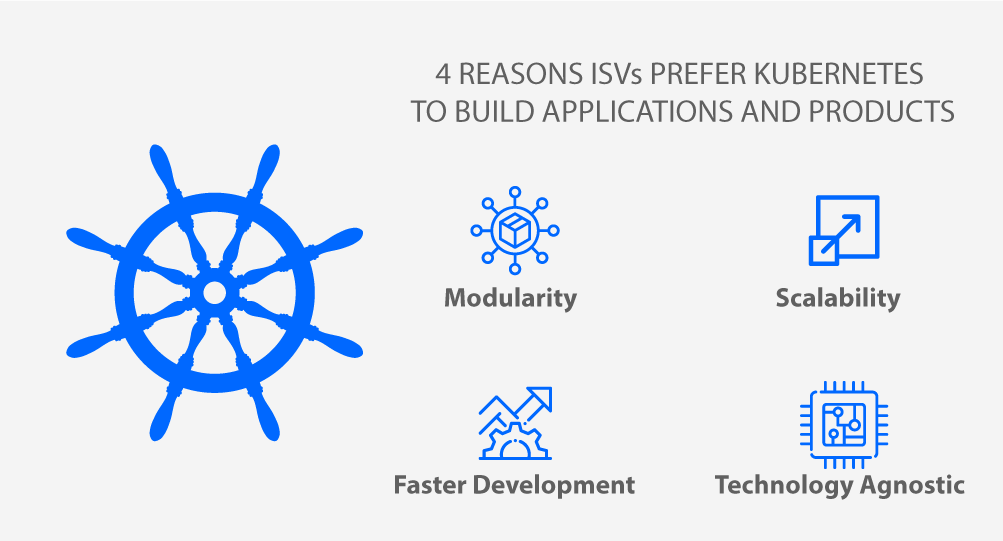



Kubernetes, also vividly known as K8s, has become enormously popular within just seven years of its release. According to a 2020 Cloud Native Computing Foundation (CNCF) survey, a whopping 91% of respondents reported choosing Kubernetes for containerization.1 Independent Software Vendors (ISVs), already among the early adopters of Kubernetes (K8s), are now actively using the power of the open-source platform across cloud-native development, automation in deployment, scaling, and management of containerized applications and products for their enterprise customers.
Besides, the Technical Oversight Committee (TOC) for Kubernetes recently announced the first release of 2021 - Kubernetes 1.21 with 51 enhancements under various stages.3 The new version of the open-source platform Kubernetes is aimed to tackle operational and security issues faced by enterprise IT organizations deploying cloud-native applications at scale.
Considering the quick penetration of Kubernetes among software engineering teams to address the high customer demand, Kubernetes has become a core component for building innovative applications and products.
As competition gets intense and customer needs evolve every day, ISVs are under pressure to launch new, innovative products and applications to meet the shifting demands. This transformed how software applications and products are developed. Monolithic architecture has been replaced with microservices to drive flexibility and pace.
Software is now written in its elemental pieces. On-premise servers are replaced with complex cloud options. The need to innovate continuously, iterate quickly, and launch often has paved the way for DevOps and Agile approaches that run on the core principles of continuous development and continuous integration (CD/CI). This has made Kubernetes a natural response to the growing need for faster and more agile development of cloud-native applications and products.
Let’s dig deeper to know why ISVs prefer to use Kubernetes for building containerized applications.
Why ISVs Prefer To Use Kubernetes To Build Better Products And Apps?
Technology and Language-Agnostic
Software development has changed rapidly in the last few years. ISVs create applications for different environments such as on-prem servers, virtualized private clouds, and public clouds such as AWS and Microsoft Azure. Earlier some ISVs used PaaS (Platform-as-a-Service) to create and push product code to the cloud.
They could save time on setting up IT infrastructures and focus on delivering value. However, PaaS had strict specifications on which programming language and application framework to use. ISVs could not use the languages or frameworks of their choice. Its restrictive nature was the primary reason that it met a lukewarm response from ISVs. That’s when Kubernetes came to the rescue.
The primary benefit of Kubernetes is that it is language and technology-agnostic. So, ISVs have the flexibility to choose any language of their choice. They can use any language such as Java, Python, Ruby, and Jsonnet to develop applications driven by factors such as the ecosystem and developer’s skill sets.
Kubernetes is compatible across all cloud environments and can function efficiently without infrastructure lock-in. ISVs want to create innovative solutions for their customers. Kubernetes helps them add value and gain an advantage over others by bringing speed and agility to the table.
 Modularity
Modularity
Instead of running a single complex application in a container, applications can be split into small modules such as a database, the front-end of the application, etc. This makes it easier for ISVs to build and manage applications and products by focusing on individual components.
In case of issues or if some change is needed, they can even rebuild just a part instead of rebuilding the whole application or product. This helps ISVs to develop applications and products rapidly.
Of course, these modules can function only if they are orchestrated and integrated together. In that context, Kubernetes is crucial in orchestrating the modular elements. Kubernetes uses Pods to control these parts and deploy them together as a single application. This eliminates the manual processes of deploying and launching applications.
The open-source platform Kubernetes also ensures that a single container does not get burdened with too many functionalities or features that share resources such as file systems, kernel namespaces, etc.
Scalability
As more enterprises undergo digital transformation, scalability has become one of their top priorities. They want their applications to be scalable to ensure that they function smoothly even during high-demand situations. That’s one more reason for ISVs to use Kubernetes.
With Kubernetes, they can scale their applications up or down more easily because of its intrinsic scalability feature. Every Kubernetes cluster comprises a pod, node components, and controller components. These three components work powerfully and flexibly together to allow applications and products to scale.
Another factor that makes Kubernetes a natural choice here is its autoscaling feature. It can automatically scale the application when there is an unexpected increase in traffic, making it easier for ISVs to manage enterprise applications and products at all times efficiently.
Faster Development
DevOps and Agile methodology have created a commonly accepted culture of collaboration among multiple and cross-technology teams. Collaboration requires communication between different teams, establishes shared accountabilities, and eventually improves the quality of products and applications. So, where does Kubernetes fit in this new, improved culture?
Kubernetes’ advantages go beyond technical capabilities. To begin with, Kubernetes helps the different teams to work together on complex, distributed systems. It helps them to respond to their customer’s needs quickly. It also enables small teams to update an application or a product 1000 times without additional resources.2
Kubernetes also leverages workflows to allow developers to write code and deploy it efficiently. This reduces the friction in the development process and enables the developers to work together seamlessly. Cooperation, collaboration, and seamless workflows help cross-technology teams function efficiently and develop applications faster.
Conclusion
Today’s ISVs favor containerization to build cloud-agnostic products and applications as it is more resilient, scalable, and portable. They have come to depend on a multi-cloud environment as it eliminates the chance of vendor lock-ins and is more cost-effective. Hence, it makes sense for ISVs to shift to Kubernetes to build products and applications.
At Xoriant, we help ISVs build cloud-agnostic products across public and private clouds with our cloud enablement offerings.
To know more about how we can support your business with cloud enablement,
Speak With Xoriant Cloud Experts
References:
1. CNF Survey
2. IBM Blog



 View Previous Blog
View Previous Blog






